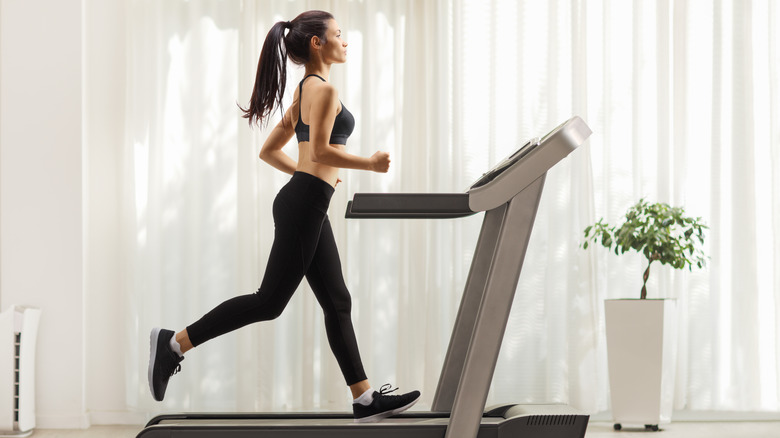The Ideal Form For Your Next Treadmill Incline Workout
For those of us who love walking and running but prefer the inside of a gym to the world outside, treadmills are a godsend. As cardio's signature old reliable, treadmills allow us to reap all the benefits of aerobic exercise without having to deal with the pitfalls that come with running outside, which can include anything from bad weather to catcalling. But a treadmill is only a useful part of your workout routine if you're using the correct form, particularly when you're moving on an incline.
Making sure you're standing and moving correctly on an inclined treadmill is pretty simple, and it starts with correcting a common mistake that many people seem to be guilty of: holding on to the treadmill. Though gripping the handles or front bar of the machine may seemingly help you to balance on an incline, it's not actually helping you to improve your balance over the long run. Life Leisure explains that holding on confuses your neuro-musculoskeletal system and makes it more difficult for your brain to assess how to balance on different surfaces in the future. Additionally, holding on to the treadmill cancels out the extra effort and burnt calories that make running on an incline worth it because your body ends up slipping into a similar position you'd hold while walking on a flat surface.
Once you break the habit of holding on to the treadmill, the rest of the ideal form largely comes down to maintaining good posture.
How to maintain good form
To maintain the healthiest form during your next incline treadmill workout, think of practicing the "good posture" you were probably instructed to use during your childhood. That means standing with a straight spine rather than a stooped or curved spine (which can happen when you're hunching over to hold on to the front bar) and looking straight ahead. You can also lean slightly forward, engaging your core rather than raising your shoulders to do so. According to Women's Health, the correct posture specifically involves keeping your torso straight so your core muscles are activated.
"This way you can lean into the hill and use your core more while maintaining traction and power landing your feet underneath you versus in front of you," Peloton Tread instructor Rebecca Kennedy revealed.
To stop yourself from holding on to the treadmill, remember to work your arms naturally with your legs. "... drive your knees up to help you climb the incline while pumping your arms at the same time to give you momentum to get up that hill," certified personal trainer Emily Nichols told Bustle.
If you don't keep your torso straight or you do end up hunched over holding on to the front bar, you could hurt your lower back and your hips.
Other incline mistakes to avoid
As incline treadmill workouts are more demanding and harsher on the joints than walking or running on the flat, you'll want to be extra careful not to make any of the most common treadmill mistakes. Shape explains that one of the biggest errors people make is forgetting to stretch and warm up before hopping on. "Skipping a warm-up puts you at risk of pulling a muscle or straining a tendon," Equinox Chestnut Hill trainer Kristen Mercier told the outlet.
Just as starting your workout is important, it's crucial to end it correctly — and that doesn't involve suddenly jumping off the treadmill. As you would in real life, gradually decrease the speed and incline of your machine and come to a natural stop. This will prevent you from accidentally hurting yourself as you jump off, and also require you to put in more effort, which can improve your stamina and muscle development.
When it comes to incline treadmill workouts specifically, The Bod Squad notes that using too much of an incline over the long-term can actually do more harm than good. The hips, knees, and ankles may become overworked, which can lead to injury. To stay safe, One Peloton recommends that beginners start with an incline of between 1 and 4%, while advanced incline users can push themselves up to 10%. Keep in mind that you can and should vary the speed and incline throughout your workout, even when you become an advanced incline runner, to avoid a plateau.


